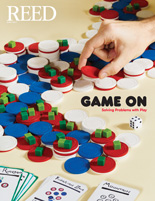
IRIS login | Reed College home Volume 96, No. 2: June 2017
Tango from the Inside Out

Max Boddy ’16 got the chance to study with some of the world's foremost tango masters at Reed's annual summer workshop, Tango for Musicians.
I dashed along SE 28th Avenue with my case on my back and my phone in hand, checking the time anxiously to see how much time I had before rehearsal. It was brutally hot for a June day in Oregon, but my sweat wasn’t due to the heat alone. I was three days into an intense, weeklong “tango bootcamp” with some of the world’s leading tango musicians. Incredibly, I was supposed to be performing with them on stage in two days. And now my violin was acting up. How did I get here, anyway?
Last year, Astillero, a contemporary tango group from Buenos Aires, visited Reed, and I had the opportunity to accompany them in Reed’s orchestra. Playing their original compositions with them was exhilarating, and I wanted to play and understand that kind of music better, so I applied for a Rothchild summer stipend to study at Reed’s summer workshop, Tango for Musicians at Reed College. But first, as was emphasized in our workshops, it is important to play and understand the classic tangos before venturing out into the new territory of tango today, so I had to learn some fundamentals—fast.
At the front counter, I explained my situation to a young luthier as I got out my violin and handed it over for inspection. It was a little hard to believe that I was about to perform tango music on the same stage as Ida Kavafian and Chamber Music Northwest. I’d often imagined something like this—I just didn’t think the opportunity would come this soon!
My days at the workshop consisted of 2 hours of violin technique, an hour of tango history, 2 hours of ensemble rehearsal—an Orquesta Tipica for me—and then an hour-long recap of the day’s themes and ideas with the whole conference playing their instruments. The faculty bassist Ignacio Varchausky taught me how to listen for the key elements of tango, and helped me to appreciate the classical tangos. Tango soon seemed less alien, and thinking and hearing tango became a baseline for my day.
Friday, the day of my first performance, rolled around quickly. When the lights finally came up on stage, Adam Tully, the guitar instructor, acknowledged that it was hot—but as an audience member remarked, the music was hotter. And there was indeed some amazing music being made that night. Performing was nerve-wracking—but also exciting.
Then, there was the performance on Saturday. The orquesta tipica I was part of would play La Mariposa and Nostalgico as an opening act for Chamber Music Northwest. I watched the audience fill up on a dingy monitor backstage, and I thought it might be an intimidating crowd. But once I got on stage, I knew this wasn’t the case at all. The audience was buzzing, and everyone on stage around me seemed to be pouring their own energy into the music too. It was an intimate and exciting experience that greatly reminded me of the performance by Astillero that drew me to tango in the first place. It’s like you’re with a bunch of friends, talking to each other and having a fantastic time—maybe a simple idea for a lot of technique, theory, creativity, and practice, but an incredibly worthwhile one. That’s what I think tango is all about.
Tags: performing arts, music, tango


LATEST COMMENTS
steve-jobs-1976 I knew Steve Jobs when he was on the second floor of Quincy. (Fall...
Utnapishtim - 2 weeks ago
Prof. Mason Drukman [political science 1964–70] This is gold, pure gold. God bless, Prof. Drukman.
puredog - 1 month ago
virginia-davis-1965 Such a good friend & compatriot in the day of Satyricon...
czarchasm - 4 months ago
John Peara Baba 1990 John died of a broken heart from losing his mom and then his...
kodachrome - 7 months ago
Carol Sawyer 1962 Who wrote this obit? I'm writing something about Carol Sawyer...
MsLaurie Pepper - 8 months ago
William W. Wissman MAT 1969 ...and THREE sisters. Sabra, the oldest, Mary, the middle, and...
riclf - 10 months ago